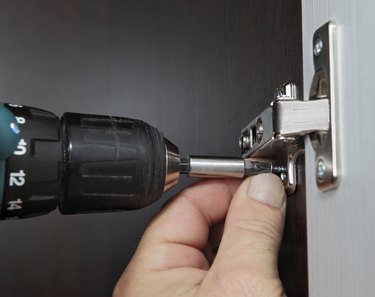
Cabinet hinge selection might seem overwhelming at first glance, as hinges don't all operate the same way. Choosing the right hinges for your cabinets begins with the cabinet type, door type, application and the overall look you want the cabinets to have. It helps to first understand the differences in how hinges are mounted and how they close, open or cushion the door to find the hinges best-suited to the application and overall appearance for your cabinets.
Hinge Versus Cabinet
Video of the Day
Hinges are divided between two types of cabinets: face-frame and frameless. Cabinets with face frames have a solid wood lip around the perimeter of the opening, typically 2 to 3 inches wide. A frameless, or European-style, cabinet has no face frame and is essentially a box with five sides. The opening is smooth and unobstructed, exposing only a 3/4-inch edge that gets covered by the door. Hinges for frameless cabinets typically mount to the inside face of the cabinet box and are invisible when the door is closed. Cabinets with face frames typically use a visible or partially visible hinge mounted to the face frame.
Video of the Day
Overlay, Off-Set or Full Inset
The degree of hinge overlay depends on how much of the door covers the opening. Doors mounted on full-overlay hinges cover the opening completely. These are standard for frameless cabinetry. Doors hung with partial or off-set overlay hinges are used on face-frame and frameless cabinets alike. If the door covers 1/2 inch of the opening it's designated as having a 1/2-inch overlay. If the door covers 3/8 inch of the opening, it's mounted on 3/8-inch overlay hinges. Another type of hinge, the full-inset, is a concealed hinge that mounts flush with the door and the cabinet opening so that the door fits completely inside the cabinet opening. The overlay, off-set or full-inset distinction should be one of the first features to consider when choosing hinges.
Concealed Hinges
Concealed or European hinges fit inside the cabinet and are typically designated for frameless cabinets. The body or cylinder of the hinge is mortised into the side of the cabinet. The installation is accomplished with a template, drill and a Forstner drill bit used to drill flat holes in wood. Concealed hinges tend to be highly adjustable, making it easy to fine-tune the door position after the door is installed.
Exposed Hinges
Exposed hinges are completely visible when the door is closed; they have equal portions on both sides, and are ideal for a rustic appearance. Butt hinges are an example of semi-concealed hinges: they attach to the inside edges of the cabinet and door, leaving only the barrel or cylinder of the hinge exposed. Unlike fully concealed or overlay hinges, which often have springs or other mechanisms to slow the door when closing, traditional exposed and semi-concealed hinges allow doors to shut without restraint.
Closing Options
Other distinctions of hinges include mechanisms. Self-closing hinges pull the door shut when it's within a few inches of the cabinet. Self-opening hinges employ a spring that propels the door open slightly when you bump it with your fingers. Soft-closing hinges slow the door to prevent it from slamming. As with any hinge, some users do not like the clunk it makes when the door contacts the cabinet. To remedy this, some manufactures add small rubber bumpers to the hinge packaging.
Hinge Installation
Weight and size of the door can make a difference when installing hinges. Cabinet doors less than 40 inches high typically require only two hinges. Larger doors, such as full-length pantry doors, require three hinges. Install hinges so that they appear balanced. Most cabinetmakers install hinges 2 inches from the top and bottom of the door and, if applicable, center one in the middle. Some hinges are specific for left- or right-hand doors -- check this distinction before purchasing.